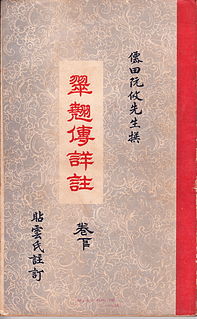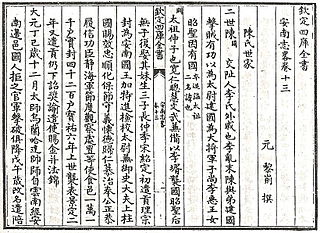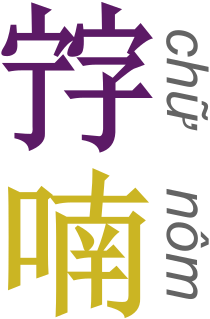
Until the beginning of the 20th century, governmental and scholarly documents in Vietnam were written in classical Chinese, using Chinese characters with Vietnamese approximations of Middle Chinese pronunciations.

The Tale of Kiều is an epic poem in Vietnamese written by Nguyễn Du (1765–1820), and is widely regarded as the most significant work of Vietnamese literature. The original title in Vietnamese is Đoạn Trường Tân Thanh, but it is better known as Truyện Kiều.

Nguyễn Bỉnh Khiêm was a Vietnamese administrator, educator, poet, sage and later a saint of the Cao Dai religion. He is referred to by several names: tên huýNguyễn Văn Đạt, Hanh Phủ (亨甫), Bạch Vân cư sĩ and Trạng Trình.
Vietnamese literature is the literature, both oral and written, created largely by Vietnamese-speaking people.

Trịnh Kiểm ruled northern part of Vietnam from 1545 to 1570. Trịnh Kiểm was the founder of the Trịnh Lords or House of Trịnh who ruled Dai Viet while a succession of figurehead Later Lê Emperors took the role as puppet government. During his rule, the war with the Mạc Dynasty continued. Although he was the de facto ruler of Dai Viet during his reign, he never claimed himself title of Lord, hence he is not the first official Trịnh Lord but his son Trịnh Tùng is the first. Later Trịnh Kiểm was posthumously proclaimed Trịnh Lord by his descendants.

The Đại Việt sử ký toàn thư is the official historical text of the Lê Dynasty, that was originally compiled by the royal historian Ngô Sĩ Liên under the order of the Emperor Lê Thánh Tông and was finished in 1479. The 15-volume book covered the period from Hồng Bàng Dynasty to the coronation of Lê Thái Tổ, the first emperor of the Lê Dynasty in 1428. In compiling his work, Ngô Sĩ Liên based on two principal historical sources which were Đại Việt sử ký by Lê Văn Hưu and Đại Việt sử ký tục biên by Phan Phu Tiên. After its publication, Đại Việt sử ký toàn thư was continually supplemented by other historians of the Lê Dynasty such as Vũ Quỳnh, Phạm Công Trứ and Lê Hi. Today the most popular version of Đại Việt sử ký toàn thư is the "Nội các quan bản" edition which was completed in 1697 with the additional information up to 1656 during the reign of the Emperor Lê Thần Tông and the Lord Trịnh Tráng. Đại Việt sử ký toàn thư is considered the most important and comprehensive historical book about the history of Vietnam from its beginning to the period of the Lê Dynasty.
Lê Hiển Tông, born Lê Duy Hiệu, was the penultimate emperor of Vietnamese Lê Dynasty. He reigned from 1740 to 1786 and was succeeded by his grandson Lê Duy Kỳ.
Thuận Hóa was a historic territory in central Vietnam. It consisted of the modern provinces of Quảng Bình, Quảng Trị, and Thừa Thiên–Huế.
Vietnamese poetry originated in the form of folk poetry and proverbs. Vietnamese poetic structures include six-eight, double-seven six-eight, and various styles shared with Classical Chinese poetry forms, such as are found in Tang poetry; examples include verse forms with "seven syllables each line for eight lines," "seven syllables each line for four lines", and "five syllables each line for eight lines." More recently there have been new poetry and free poetry.

Bình Ngô đại cáo was an announcement written by Nguyễn Trãi in 1428 after the order of Lê Lợi to proclaim the total pacification of the Ming Dynasty and affirm the independence of Đại Việt to its people.

The An Nam chí lược is a historical text that was compiled by the Vietnamese historian Lê Tắc during his exile in China in early 14th century. Published for the first time in 1335 during the reign of the Yuan Dynasty, An Nam chí lược became one of the few historical books about Đại Việt that survive from the 14th and 15th centuries and it is considered the oldest historical work by a Vietnamese that has been preserved.

Dream memoir of Southern Man is a memoir written by Vietnamese official Hồ Nguyên Trừng during his exile in Ming dynasty in the early 15th century.

Nguyễn Quảng Tuân (1925-) is a writer, poet and researcher in South Vietnam. He was born in the village of Yên Mẫn, the district Võ Giàng, the province of Bắc Ninh, northern Vietnam.
The Hạnh Thục ca is the best known work of Nguyễn Thị Bích, a Vietnamese court lady. The poem describes her experiences in the 1885 flight of Hàm Nghi. It is written in vernacular chữ Nôm using lục bát verse.
The Truyện Thạch Sanh is a late Eighteenth Century Vietnamese classical novel written in vernacular nôm script and lục bát ("6-8") verse. The author is unknown. Popular elements in the story are also taken from Vietnamese mythology.
The Story of Phạm Tải and Ngọc Hoa is an anonymous 18th Century Vietnamese language epic poem of 934 verses.
The Institute of Hán-Nôm Studies, or Hán-Nôm Institute in Hanoi, Vietnam is the main research centre, historical archival agency and reference library for the study of chữ Hán and chữ Nôm texts in Vietnam. These are texts predating the adoption of the modern Latin-based Vietnamese alphabet.
Girolamo Maiorica was a 17th-century Italian Jesuit missionary to Vietnam. He is known for compiling numerous Roman Catholic works written in the Vietnamese language's demotic chữ Nôm script, both on his own and with assistance from local converts. Maiorica was one of the first authors of original Nôm prose. His works are seen as a milestone in the history of Vietnamese literature.

Chữ Nôm, in earlier times also called quốc âm or chữ nam, is a logographic writing system formerly used to write the Vietnamese language. It used the standard set of classical Chinese characters to represent Sino-Vietnamese vocabulary and some native Vietnamese words, while new characters were created on the Chinese model to represent other words.

Literary Chinese was the medium of all formal writing in Vietnam for almost all of the history of the country up to the early 20th century, when it was replaced by vernacular writing using the Latin-based Vietnamese alphabet.











